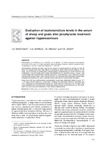Evaluation of isometamidium levels in the serum of sheep and goats after prophylactic treatment against trypanosomosis

View/
Date
2004Author
WESONGAH, J.O.
MURILLA, G.A.
KIBUGU, J.K.
JONES, T.W
Metadata
Show full item recordAbstract
Evaluation of isometamidium levels in the serum of sheep and goats after prophylactic treatment against trypanosomosis. Onderstepoort Journal of Veterinary Research, 71:175–179 Isometamidium chloride has been used for the control of trypanosomosis in animals for over 36 years, but recently there have been reports of prophylaxis failure under natural conditions. In this study, use of the drug for prophylactic purpose against trypanosomosis in small ruminants was investigated. Forty-two sheep and 44 goats were divided into four treatment groups. Groups 1 and 2 were treated with isometamidium chloride (Samorin, Rhone Merieux, Lyon, France) at 3-month intervals while groups 3 and 4 were used as controls. All the animals were exposed to natural tsetse challenge and monitored for serum isometamidium levels and anti-trypanosome antibodies. Seven days after drug administration, isometamidium levels were significantly higher in goats 13.7 ± 0.07 ng/ml than in sheep 6.2 ± 0.06 ng/ml. However, the elimination half-life in the sheep was 14.2 ± 0.92 days and was significantly higher (P > 0.05) than that of the goats 12 ± 0.5 days. This study established that isometamidium metabolism differs between sheep and goats and this difference may have important implications in high tsetse challenge areas.
